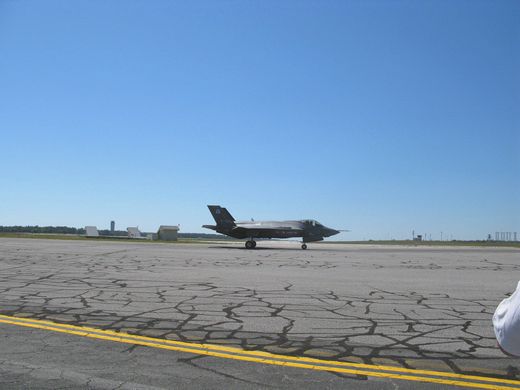Goodwill Mission
To residents of Florida’s Gulf Coast, the Joint Strike Fighter says “Won’t you be my neighbor?”
/https://tf-cmsv2-smithsonianmag-media.s3.amazonaws.com/filer/f35-hallion-flash.jpg)
At 2:44 p.m., under a hot Gulf sun and brilliantly clear-blue sky, the first Lockheed Martin F-35 Lightning II Joint Strike Fighter (JSF) arrived at Eglin Air Force Base, near Pensacola, Florida. Accompanied by a watchful two-seat F-16 from the Air Force’s 46th Test Wing at Eglin, “AA-1,” the Air Force variant of the joint-service multinational fighter, made a straight-in approach, taking onlookers by surprise at its sudden appearance low on the horizon, almost over the runway threshold. As reporters scrambled to get cameras pointed at the target, both jets added power and accelerated into a graceful left-hand chandelle, passing wings-vertical in a tight two-ship formation, a symbolic handoff of the old to the new.
Lockheed Martin test pilot Jeff “Slim” Knowles then touched down smoothly, ending a mission that had begun with takeoff at the contractor’s plant in Ft. Worth at 1:23 p.m. Led by a “Follow Me” vehicle and trailed by an Air Force Security Police car, the compact grey jet, emblazoned with nine flags of JSF partner nations, taxied past a waiting group of reporters, base officials, Lockheed Martin representatives, and local government officials, on its way to take a temporary perch on the Air Force Materiel Command side of the base.
The F-35 is here at Eglin to show base personnel and area residents what it will be like to have Joint Strike Fighters as neighbors. The Air Force plans to deploy an initial batch of 59 F-35s beginning early next year, and to increase the number eventually to 107. But full deployment will depend on overcoming some local opposition, and the service has already made concessions to win local support, chief being a recent “Record of Decision” which put off full F-35 deployment pending final environmental review and clearance of legal challenges.
Even so, citing noise and environmental concerns, the mayor and some residents of Valparaiso, the city just to the east of the base, have gone to court to secure a permanent injunction against the Air Force plan. The irony of the objection isn’t lost on F-35 supporters in the area, some of whom remember that, in times gone by, the day and night sky over the city was routinely rent by noisy jets ranging from booming F-100 “Huns” to howling F-104 ‘Zippers” and rumbling F-4 “Rhinos” (not to mention the occasional deafening B-36, B-52, and B-58)—with seemingly nary a protest.
Alarmed that “Val-P” might hurt their own interests, other Eglin area communities and citizens are fighting back, launching their own legal counter-actions and a vigorous media campaign. Local billboards, newspapers, and talk shows stridently warn of jobs and income to be lost if the F-35 goes away, and pro-F-35 signs and bumper stickers abound—even in Valparaiso.
For all the talk of noise, the Joint Strike Fighter’s arrival was surprisingly placid. During its fly-over, the F-35 (at least to this listener) sounded more like an F-16, and less loud than the twin-engine F-15Cs and F-15Es that routinely rocket off Eglin’s runways. It was certainly less disruptive than a departing F/A-18 Hornet: That noisy visitor, taking off as the F-35 mutely passed by waiting reporters, literally thundered aloft, its crackling afterburning departure calamitous in comparison to the inoffensive hot whistle emanating from the JSF.
The F-35 is so powerful for its size and weight that, unlike any other fighter aircraft (except the F-22A Raptor), it can take off in “military power,” meaning without using its afterburner. As a result, though its afterburning noise levels are comparable to those of existing fighters, in practice it is much quieter around a base simply because it doesn’t require the brute power of an afterburner to leap into the air. And it climbs to altitude much more quickly. Hearing it pass overhead the day after it arrived, most residents and players on Shalimar Point’s golf course—as I can personally attest—didn’t even look up.
The F-35 is impressive. Its clean lines hint of aerodynamic and propulsive refinement; its shape suggests stealth. As it passes, the size of its single exhaust gives an indication of the power available to the pilot of this “Fifth Generation” multirole fighter, designed to replace older non-stealthy “legacy” fighters like the F-16, AV-8, and F/A-18.
With a $40 million price tag (in FY 2002 dollars), the F-35 isn’t cheap, but the capabilities it brings to any future conflict (in an uncertain world characterized by advanced SAMs, radars, and fighters that already render much of America’s joint-service fighter force obsolescent) make it a good partner for its bigger air dominance brother (and Lockheed Martin stablemate), the F-22A Raptor.
The Air Force and Lockheed Martin had originally planned to fly AA-1 to Eglin on Tuesday, April 21, but, new airplanes being what they are, shortly before its departure (as Lockheed Martin F-35 communications director Christian “Chris” Geisel dutifully reported), the plane’s built-in self test system (known as “BITS” in the purposeful jargon-speak of aerospace engineers) “showed an anomaly in the flight control system.” (“The [BITS] system is very conservative,” he confided). Prudence dictated a precautionary delay to check out the plane, and so it arrived a day later, making up for any embarrassment by landing “Code One”: in short, in perfect operating condition.
Richard P. Hallion, former Air Force historian, is an Air & Space contributing editor.


